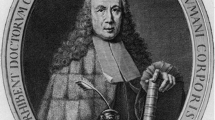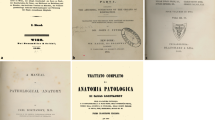Summary
It is well known that Padua Medical School, Italy, played a fundamental role in shaping modern medicine. Its golden age lasted from the late XV to the late XVIII century, thanks in particular to its extraordinary anatomical school. One of the last fundamental achievements of the Padua Medical School was the founding of the anatomo-clinical method and organ pathology by Giovanni Battista Morgagni, Professor of Theoretical Medicine in Padua from 1711 and 1715 and of Anatomy from 1715 to his death. This method, which dramatically changed the course of medical diagnosis and therapy, was immediately developed by the so-called Anatomo-Clinical School of Paris. Figures such as Jean-Nicolas Corvisart and René Laennec improved this new approach in the clinical setting with the method of auscultation and the introduction of the stethoscope. However, organ pathology probably found its most important modern expression in the so-called Viennese School of Medicine, thanks to figures such as Karl von Rokitansky, Joseph Skoda and Theodor Billroth. In that period, this school was described by the anatomist Rudolf Virchow as “the Mecca of medicine.” As is well known, Padua and Venice fell under the rule of the Austro-Hungarian Empire between the end of the XVIII and the beginning of the second half of the XIX century. The most important influences and changes at the University of Padua were introduced by the Viennese School during the so-called Third Austrian Domination (1813–1866), with improvements of medical curriculum, the founding of new specialist medical institutes and a general advancement of medical science, inspired by the technical–practical approach typical of this school. In particular, the new chair and Institute of Pathological Anatomy was founded by Lodovico Brunetti, pupil of Rokitansky, who influenced his appointment at Padua. In this way, we can advance that, at the end, the Morgagni method came back to Padua through the leading role of the Vienna Medical School, which deeply influenced the University of Padua during the different phases of Austrian domination in north Italy.

Similar content being viewed by others
References
Rossetti L. The university of Padua. An outline of its history. Trieste: LINT; 1983.
Tsoucalas G, Karamanou M, Androutsos G. The eminent Italian scholar Pietro d’Abano (1250–1315) and his contribution in anatomy. Ital J Anat Embryol. 2011;116:52–5.
Zampieri F. Medicine in Padua at the time of Linacre: methods and epistemology. In: Marrone D, Luxon L, Thiene G, editors. English students of medicine at the university of Padua during the renaissance and the diploma of doctor of medicine of William Harvey. Padua: Padova University Press; 2016. pp. 25–43.
Zampieri F. Andreas Vesalius’s epistemological revolution. In: Zampieri F, Zanatta A, Basso C, Thiene G, editors. Andreas Vesalius 500 years later. Padua: Cleup; 2019. pp. 89–134.
Benedetti A. Historia corporis humani sive Anatomice. Venetiis: Bernardino Guerralda vercellese; 1502.
Vesalius A. De humani corporis fabrica libri septem. Basel: Oporinus; 1543.
Premuda L. Le conquiste metodologiche e tecnico-operative della medicina nella Scuola padovana del secolo XV. In: Poppi A, editor. Scienza e filosofia all’Università di Padova nel Quattrocento. Padua: Centro per la Storia dell’Università di Padova; 1983. pp. 394–428.
Cassirer EA. The place of Vesalius in the culture of Renaissance. Yale J Biol Med. 1943;16:109–20.
Zampieri F. Il metodo anatomo-clinico fra meccanicismo ed empirismo. Marcello Malpighi, Antonio Maria Valsalva e Giovanni Battista Morgagni. Roma: L’Erma di Bretschneider; 2016.
Zanatta A, Zampieri F, Zampieri G, Giuliodori A, Thiene G, Caenazzo L. Identification of Giovanni Battista Morgagni remains following historical, anthropological and molecular studies. Virchows Arch. 2014;465:501–8.
Zampieri F, Zanatta A, Thiene G. An etymological “autopsy” of Morgagni’s title: De sedibus et causis morborum per anatomen indagatis (1761). Hum Pathol. 2014;45(1):12–6.
Zampieri F. Da Morgagni alla patologia molecolare. Teorie e modelli dell’anatomia patologica. Padova: Libraria Padovana Editrice; 2012.
Weiner DB, Sauter MJ. The city of Paris and the rise of clinical medicine. Osiris. 2003;18:23–42.
Laennec R. De l’auscultation médiate ou traité du diagnostic des maladies des poumons et du cœur fondé principalement sur ce nouveau moyen d’exploration. II. Paris: Brosson & Chaudé; 1819.
Rokitansky-Tilscher U. The influence of the neighboring countries and sciences and the international spread of Viennese medicine: Carl Freiherr von Rokitansky’s international relationships. Wien Med Wochenschr. 2020; https://doi.org/10.1007/s10354-019-00725-1.
Skoda J. Abhandlung über Perkussion und Auskultation. Wien: J. Ritter von Mösle’s Witwe & Braumüller; 1839.
Lesky E. Joseph Skoda. Wien Klin Wochenschr. 1956;28:726–9.
Rokitansky K. Handbuch der pathologischen Anatomie. Vol. III. Wien: Braumüller & Seidel; 1846.
Prichard R. Selected items from the history of pathology: Karl von Rokitansky (1804–1878). Am J Pathol. 1979;97:276.
Premuda L. L’asse Vienna-Padova nella medicina dell’Ottocento e i suoi riflessi sul piano didattico e scientifico. Padova: Società Cooperativa Tipografica; 1981.
Vogl A. Six hundred years of medicine in Vienna. Bull N Y Acad Med. 1967;43:282–99.
Holubar K. Paul de Sorbait (1624–1691): on the 300th anniversary of his death. Wien Klin Wochenschr. 1991;103:585–7.
Kidd M, Modlin IM. Van Swieten and the renaissance of the Vienna Medical School. World J Surg. 2001;25:444–50.
Percebois I. Medical developments in the 19th century: the Vienna Clinical School. Medicographia. 2013;35:350–61.
Bernard PP. The Limits of Absolutism: Joseph II and the Allgemeines Krankenhaus. Eighteenth Century Stud. 1975;9:193–215.
Rippa Bonati M. Dall’Ospedale di San Francesco Grande al Giustinianeo. Padova E Il Suo Territ. 2004;19:22–4.
Ongaro G. Alle origini dell’ospedale Giustinianeo. Padova E Il Suo Territ. 2007;22:41–4.
Ongaro G. Medicina, Farmacia, Veterinaria. In: Del Negro P, editor. L’Università di Padova. Otto secoli di storia. Padua: Signun Padova; 2001. pp. 241–9.
Berti G. L’Università di Padova dal 1814 al 1850. Treviso: Edizioni Antilia; 2011.
Lamprecht R. Manuale di ostetricia teorica e pratica per le alunne levatrici. Padua: Minerva; 1837.
Rosas A. Handbuch der theoretischen und practischen Augenheilkunde. III. Wien: Druck und Verlagd von J.B. Wallishausser; 1830.
Zampieri F, Comacchio F, Zanatta A. Ophthalmologic wax models as an educational tool for 18th century vision scientists. Acta Ophthalmol. 2017;95:852–7.
Premuda L. Die Einführung der Perkussion und der Auskultation in das „Studio Medico“ von Padua. In: Lindeboom GA, editor. Circa Tiliam: Studia Historiae Medicinae Gerrit Arie Lindeboom Septuagenario Oblata. Leiden: Brill; 1974. pp. 230–55.
Zanatta A, Thiene G, Valente ML, Zampieri F, editors. Testo atlante di patologia nella storia. Dal Museo di Anatomia Patologica dell’Università di Padova. Text atlas of historical pathology. From the Museum of Pathological Anatomy of Padua University. Treviso: Antilia; 2015.
Zampieri F, Zanatta A, Rippa Bonati M. L’enigma della “suicida punita”. Un grottesco preparato anatomico di Lodovico Brunetti (1813–1899) vincitore della medaglia d’oro all’Esposizione Universale di Parigi del 1867. Physis. 2012;48:297–338.
Brunetti L. Prolusione allo insegnamento dell’anatomia patologica recitata il giorno 16 aprile 1855 dal professore dr. Lodovico Brunetti di Rovigno nell’assumere questa cattedra di nuova istituzione presso l’I.R. Università di Padova. Padova: Angelo Sieca; 1855.
Author information
Authors and Affiliations
Corresponding author
Ethics declarations
Conflict of interest
The author certifies that he has no affiliations with or involvement in any organization or entity with any financial interest, or non-financial interest in the subject matter or materials discussed in this manuscript.
Additional information
Publisher’s Note
Springer Nature remains neutral with regard to jurisdictional claims in published maps and institutional affiliations.
Rights and permissions
About this article
Cite this article
Zampieri, F. Exchanges and interactions between Padua and Vienna medical schools in the XIX century. Wien Med Wochenschr 170, 249–254 (2020). https://doi.org/10.1007/s10354-020-00754-1
Received:
Accepted:
Published:
Issue Date:
DOI: https://doi.org/10.1007/s10354-020-00754-1




